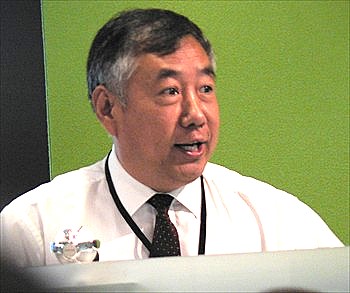
Edwin Goh, CFO, China Animal Healthcare. Photo by Leong Chan Teik
SOMETIMES the investment value of a business gets focused in a compelling way in just a couple of sentences during a road show.
That was the case recently when Edwin Goh, the CFO of China Animal Healthcare (CAH), pointed out that for the company’s listing on Dec 31 of 2007, the stock was sold at 20 cents.
CAH, at that time, derived 94% of its sales from powdered drugs for farm animals and the remaining 6% from injection drugs.
Nearly two years on, the animal drugs manufacturer has grown a lot: It has a biological drug (vaccines) manufacturing business that is set to become even larger next year than the powdered drugs business after its announced acquisitions are completed.
Yet CAH’S stock price traded at just 22 cents of late, which potentially offers investors bang for their buck. “Investors are getting twice the value for this same price,” said Edwin at his presentation to analysts and fund managers at a Financial PR conference last week featuring five companies with a strong China theme.
“Of course, there’re execution risks in the acquisition plans we have but a lot of investors are sitting up and hearing us out in our road shows.”

Snapshot of CAH
In May this year, Legg Mason was among those who took up a total of 130 million new shares issued in a placement exercise at just 11 cents apiece. That probably was an easy decision as CAH stock was trading at just around 5X historical earnings.
Aside from taking up 80 million new shares, Legg Mason bought from the open market another 9.3 million shares at 14.71 cents apiece, for a total stake of 6.83%.
However, taking another view on CAH, it was announced in April that Arisaig Greater China Fund had sold CAH shares in the open market, cutting its stake from 5.05 % to 2.43 %.
Biological drugs: New growth driver
The contribution from the biological drugs business segment:
* In the first half of this year, sales of biological drugs contributed RMB 27.4 million, or 15.6% of CAH’s total sales.
* The gross profit margin of the vaccines was 71.3%, slightly lower than the 77.4% chalked up by powdered drugs.

CAH has strong operating cashflow because it collects cash on delivery to its retailers.
How acquisitions of biological drugs businesses can substantially boost CAH’s prospects was illustrated by Edwin using the example of a former state-owned company acquired by CAH in the first half of 2008.
The company had sales of RMB3 m in 2007 and a net loss of RMB2 million. In the 7 months that CAH controlled this company in 2008, it raked in RMB 39 million sales and RMB 18 m net profit.
The reason: CAH pushed the subsidiary’s products through CAH's wide sales network, providing an instant solution to the biggest challenge facing the subsidiary previously.
Another positive development took place at the subsidiary, Shanxi Longkeer, which had the licence to manufacture swine fever vaccines but had not started doing so. Under CAH, it has become the first private company in China to manufacture those vaccines.
CAH has two acquisitions in the pipeline:
* Inner Mongolia Biwei Antai Biological Technology Co: CAH has received shareholder approval to acquire for RM 288 m a 60% stake in the company which is completing the construction of a manufacturing plant this quarter. The facility will manufacture biological animal drugs - particularly, vaccines for animal hand, foot and mouth disease.
The relevant certification and production licences are expected to be obtained in the last quarter of 2009. The new acquisition is expected to contribute substantially to the Group’s results when operations commence.

CAH chairman Wang Yan Gang also spoke at the conference. Photo by Leong Chan Teik
* Beijing Jianxiang Hemu Biological Technology: CAH has signed a letter of intent to acquire 100% of the company, which has developed a potential new vaccine against the Porcine Reproductive and Respiratory Syndrome ("PRRS"), also known as pig's blue ear disease.
It is currently in the process of obtaining a licence from the PRC Ministry of Agriculture (MOA) to manufacture and sell the vaccine.
If the licence is granted, the target company joins a very select group of PRC companies - a grand total of three so far - that the MOA has to-date designated to conduct research and develop potential new vaccines against the PRRS virus.
Under MOA’s requirements, the application of such vaccines to pigs is mandatory and the costs of purchase of these vaccines are paid for entirely by the PRC government.
So what could be the impact of the two acquisitions have on CAH's earnings growth? CAH's financials would transform into a different kind of animal, so to speak.
Edwin said as a result of these acquisitions, CAH’s biological drugs could contribute 60-70% of the group’s revenue, exceeding that of powdered drugs (now 70%).
DBS Vickers’ 27-cent target price
DBS Vickers Securities in an Aug 4 research report said it expected CAH to grab 20% of China’s HFM (hand-foot-mouth) vaccine market when Bewei Antai commences production end-2009, which will boost Group’s earnings by c. 45% from FY2010 onwards. Its price target of 27 cents, based on 10x FY10 P/E, is pegged to its closest peer and backed by 45% earnings growth expected in FY2010. ”The Group’s earnings growth in FY2010 is highly dependent on the successful launch of HFM vaccine. Hence, downside risk mainly lies in the ramp-up of the new plant. BUY (initiating coverage)." |
Why does China Animal Healthcare enjoy 70+% gross profit margins? Read our 2008 report: CHINA ANIMAL HEALTHCARE: Strong double-digit growth expected this year






